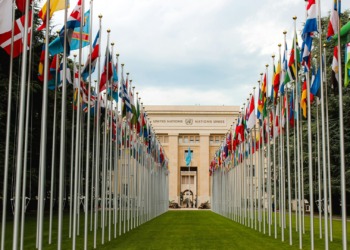Article 6 of the 2015 Paris Agreement details how countries can cooperate to achieve their greenhouse gas emission reduction targets, as set out in their nationally determined contributions (NDCs).
While the majority of climate mitigation action is expected to take place within countries’ jurisdictions, Article 6 recognizes that these efforts can be effectively complemented through cooperation among governments and others to cut emissions and support credible carbon offset projects.
After years of negotiations, at the 2021 COP26 in Glasgow, the Parties to the UN Framework Convention on Climate Change agreed to a detailed set of rules for these carbon credit transfers, essentially creating a fledgling international public carbon market.
Baby steps toward a public carbon market under Article 6.2
Article 6.2 covers government-to-government carbon credit deals where the credits — known as Internationally Transferred Mitigation Outcomes — are reported to a central registry.
To date, there have been three bilateral Article 6.2 deals, each with Switzerland as the buyer. These deals support low-carbon rice cultivation in Ghana, electric buses in Thailand, and solar panels in Vanuatu, respectively.
They resemble bilateral government cooperation agreements rather than market-level deals: Switzerland has published the general terms of the agreement, including dispute mechanisms through bilateral processes, but does not mention a carbon price.
Compared with the roughly 260,000 voluntary carbon deals since 2010, it is an understatement to say that public carbon deals under Article 6.2 are off to a slow start.
The good news is that close to 130 bilateral pre-feasibility projects are now up and running. Most involve bilateral agreements between a developed and a developing country on energy efficiency and renewable energy projects. A few explore issuing carbon credits between developed countries for carbon capture and storage (CCS).
While nature-based carbon solutions like forest or peatland carbon offsets have barely featured under Article 6.2 until now, in September 2023, Suriname became the first country to announce plans to sell forestry-based Internationally Transferred Mitigation Outcomes under Article 6.2 (at USD 40 per tonne).
Private carbon markets in disarray
It is too early to determine whether Article 6.2 will help create an international carbon exchange that contributes significantly to climate mitigation efforts. What we do know is that the reputation of international carbon markets is at a low ebb; the backdrop to the Article 6.2 efforts is troubling.
The reputation of voluntary private carbon markets has been tarnished by recent media revelations and academic reports, as well as lawsuits based on companies’ carbon offsetting and “carbon neutrality” claims — such as the USD 1 billion suit facing Delta Air Lines.
Economist John Maynard Keynes deemed unregulated international financial markets a “parody of an accountant’s nightmare.” Today’s international carbon markets appear to match this characterization rather too well.
Earlier this year, an investigation by The Guardian concluded that 90% of carbon credits for land-based removal of carbon dioxide approved by Verra — among the world’s leading carbon offset certifiers — were “useless.” Similarly, a Goldman School assessment said that voluntary carbon credits have been “exaggerated across all quantification factors.”
While projecting that global carbon offset trading will grow 15-fold by 2030 and 100-fold by 2050, the United States’ Fifth National Climate Assessment, published earlier this year, politely noted “concerns” about carbon markets.
In response, there have been growing calls for governments to regulate private-sector carbon markets. While 39 jurisdictions have carbon emission trading systems in place, only a handful— notably, California and British Columbia — have rules covering carbon offsets.
Developed countries are slowly addressing this regulatory deficit in private carbon markets. A new European Union (EU) carbon removal certification framework proposes a verification system for all EU-based carbon credit claims, while the European Parliament and Council recently reached a provisional agreement on new rules to ban misleading environmental claims and “greenwashing” advertisements. Canada plans to release federal carbon offset regulations in 2024.
That said, even if these initiatives turn out to be impactful, they will only cover a small part of the global carbon credit market.
What is a true carbon credit — and what is greenwashing? Article 6.4 expert body to deliver key guidance
All of this leads us to the second pillar of Article 6: Article 6.4. When the Paris Agreement’s international carbon market rules were adopted, Article 6.4 was initially considered the part of the rulebook with the greatest potential.
Tasked with developing standards, guidance, and methodologies for carbon markets and credits, Article 6.4 and its Supervisory Body have spent the last two years doing just that. The successor to the older Clean Development Mechanism, under which some 3,300 projects were approved, Article 6.4 is due to come into force in 2024 or 2025.
To date, the 12-person Supervisory Body to Article 6.4 has advanced some welcome standards, notably setting out under what conditions carbon removals from forests, grasslands, peatlands, and other natural ecosystems can be counted toward a carbon credit.
The same guidance concludes that all CCS projects should be disqualified from Article 6.4. The expert body excluded natural carbon uptakes that are “not directly caused by human activities” in its definition of carbon dioxide removals and has deemed engineered CCS projects as outside of its scope, which created a predictable backlash from the CCS industry.
One consequence of this definition could be that more CCS projects will instead be advanced between governments (under Article 6.2) in the future. Indeed, several of the provisional government-to-government agreements mentioned above already refer to CCS projects.
The additionality dilemma
Many specific rules await the finalization of the Supervisory Body; of these rules, guidance around additionality is among the most urgent.
A lightning rod for much of the criticism of carbon credits and the offset industry, additionality refers to the need to demonstrate that the reduction or removal of carbon emissions was created by the specific carbon credit project and would not have occurred without it.
The Supervisory Body’s current definition of additionality includes revenues from carbon credits (financial additionality), the impacts of regulations (impacts of laws and industry standards), changes in practices (common practice additionality), and performance against industry or sector benchmarks (performance additionality).
Since the concept is based on comparisons against a hypothetical counterfactual, it is likely that the carbon market rules on additionality will emerge from evolving practices, as well as the Supervisory Body’s guidance.
For example, while carbon credits from solar and wind projects are an important focus of Article 6.2 projects, most experts argue that since the price of renewable energy is at parity with fossil fuels, the case for renewables’ additionality will become increasingly limited.
Upcoming guidance on the amount of time carbon must be stored for it to be a valid carbon credit — “permanence” in carbon market jargon — and how to ensure that carbon stored in one place is not lost somewhere else — known as “carbon leakage” — is also much anticipated.
Article 6.8 to help tackle the triple crises of debt, climate, and nature?
The third pillar of Article 6 (Article 6.8), which covers non-market forms of international cooperation for emission reductions, is the least examined to date.
This is likely to change, as Article 6.8 is beginning to explore several important — and innovative — forms of international climate cooperation. One of them is technology transfers, which was identified as a key part of the pillar already in the 2015 Paris Agreement.
Already, 2023 is set to see a record USD 1.7 trillion investment in low-carbon technologies like solar, wind, heat pumps, and electric vehicles. Article 6.8 opens up new opportunities for major technology producers to export clean technologies to developing countries below market cost in exchange for carbon credits.
Related Articles: Why Carbon Credit Schemes May Not Work as Intended | Carbon Offsets: What Are ‘Phantom Credits’? | Are Carbon Offset Schemes a Pretext for Big Polluters | Why Do Carbon Offsets Not Effectively Offset Carbon? | The Voluntary Carbon Market: Unregulated and Useless? | Microsoft’s New Investment in Carbon Removal: A Landmark Deal to Eliminate 1.5 Million Tons of Carbon | Are Carbon Offsets Worsening the Climate Crisis?
More recently, governments have identified debt-for-climate swaps as another topic for Article 6.8. Earlier this month, leading multilateral development banks launched a task force that will help developing countries get additional access to climate finance, including through debt-for-climate swaps.
Led by the Inter-American Development Bank and the U.S. International Development Finance Corporation, this task force is an important opportunity to align public financing and Article 6.8 to address the triple crises of crippling public debt, climate change, and nature loss.
One World Bank project that aims to tackle this triple crisis innovation can be found in Uruguay, where interest rate payments on loans for the livestock sector are reduced if the country achieves methane emission reduction targets below those in the country’s NDC.
Perhaps most promising is the possibility of Article 6.8 generating financing for intact natural areas, which has been discussed at several recent meetings of the Subsidiary Body for Scientific and Technological Advice.
Can Article 6 turn into an asset for climate action? Three things to focus on
The discussion of carbon markets has been dominated by revelations of their pitfalls, a lack of oversight, and an inability to contribute to climate mitigation and nature protection efforts in a meaningful way. And with good reason.
Both earlier attempts at international public carbon markets and current voluntary carbon markets have overpromised and under-delivered. Investors are now walking away, with voluntary markets contracting by 19% between 2020 and 2021.
Yet rather than scrapping them, it is more important than ever to make international cooperation on emission reductions and nature protection work in ways that yield long-term climate benefits while supporting sustainable development and global equity.
To make Article 6 and its pillars deliver on its potential, vital lessons can be learned from a growing portfolio of multilateral development bank (MDB) projects that have managed to improve country-based carbon credit projects, make such projects comparable between countries, and provide standardized rules around transparency, reporting, and accountability throughout the lifespan of these carbon offset programs.
These MDB efforts include support for clarifying uncertain land rights in forest carbon offset projects, work at jurisdictional levels to reduce the risk of carbon leakage, and the development of benefit-sharing schemes.
While its progress so far has been too slow and marred by the persistent dark clouds hovering over global carbon markets, Article 6 and its three pillars can play an important role in guiding both public and private carbon markets out of their current malaise. To do so, its policy-makers need to accelerate their work and deliver on three main areas in the coming 12 months.
- Rule Completion: Article 6.4 is due to become operational in late 2024 or early 2025. While the Supervisory Body has been busy examining different possible rules, it now needs to accelerate this work and complete a clear, concise, and workable set of standards in the next 12 months. Important rules for additionality, leakage, permanence, and safeguards—as well as processes for appeals and grievance—need to be completed soon to enable a functioning public carbon market to grow.
- Coherence: While Article 6 mandates three distinct approaches, it is important to ensure some overarching rules and principles across the three pillars, particularly those rules that determine the approach to additionality, permanence, and leakage. Contradictory approaches—for example, the inclusion of CCS in Article 6.2 but its exclusion from 6.4—will undermine the integrity of the whole system.
- Blended Finance: With voluntary carbon markets still reeling from damaging media stories, private investment in carbon markets has dropped by nearly 20% since 2021. One option to address this decline is to expand recent work among MDBs, led by the World Bank, in de-risking Article 6 international deals with the aim of crowding in private investors.
** **
This article was originally published by the International Institute for Sustainable Development (IISD) and is republished here as part of an editorial collaboration with the IISD.
Editor’s Note: The opinions expressed here by the authors are their own, not those of Impakter.com — Featured Photo Credit: Wirestock.









